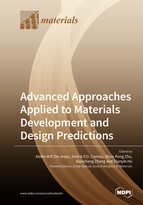Advanced Approaches Applied to Materials Development and Design Predictions
A special issue of Materials (ISSN 1996-1944).
Deadline for manuscript submissions: closed (31 December 2019) | Viewed by 39828
Special Issue Editors
Interests: manufacturing processes; simulation; fracture mechanics
Special Issues, Collections and Topics in MDPI journals
Interests: numerical modeling of engineering structures and structural components (offshore applications, steel bridges, pressure vessels, pipelines, wind turbine towers, etc.); mathematical problems in fatigue and fracture; mechanics of solids and structures; metals materials and structures; numerical fracture mechanics and crack growth; local approaches; finite element methods in structural mechanics applications; computer-aided structural integrity
Special Issues, Collections and Topics in MDPI journals
Interests: structural integrity and reliability analysis; damage tolerance design and life prediction; artificial intelligence and health assessment
Special Issues, Collections and Topics in MDPI journals
Interests: multi-physics damage modeling; high temperature fatigue; fatigue-creep interaction; life design and prediction; structural integrity; damage tolerance
Special Issues, Collections and Topics in MDPI journals
Interests: additive manufacturing; fatigue; fracture; multiscale modeling; in-situ experiments
Special Issues, Collections and Topics in MDPI journals
Special Issue Information
Dear Colleagues,
Fatigue damage represents one of the most important types of damage to which structural materials are subjected to in normal industrial services, which can finally result in a sudden and unexpected abrupt fracture. Since metal alloys are still the most used materials in designing a majority of components and structures able to carry the highest service loads, the study of the different aspects of metals fatigue attracts the permanent attention of scientists, engineers and designers.
The first International Colloquium on Mechanical Fatigue of Metals (ICMFM) was organized in Brno, Czech Republic in 1968. Afterwards, regular Colloquia on Mechanical Fatigue of Metals started in 1972 also in Brno and were originally limited to participants form the countries of the former “Eastern Block”. They continued until the 12th Colloquium in 1994 (Miskolc, Hungary) every two years. After a break twelve years long, the Colloquia restarted in 2006 (Ternopil, Ukraine), followed by the ones in 2008 (Varna, Bulgaria), 2010 (Opole, Poland), 2012 (Brno, Czech Republic), 2014 (Verbania, Italy), until the last one, which was organized in 2016 in Gijón (Asturias), Spain, with the aim of opening the Colloquium to participants from all countries interested in the subject of fatigue of metallic materials.
The XIX International Colloquium on Mechanical Fatigue of Metals (ICMFM XIX) will be organized in 5–7 September 2018, at the Faculty of Engineering of the University of Porto, in Porto City, located at seaside in the northwest region of Portugal. This International Colloquium is intended to facilitate and encourage the exchange of knowledge and experiences among the different communities involved in both basic and applied research in this field, the fatigue of metals, looking at the problem of fatigue from a multiscale perspective, and exploring analytical and numerical simulative approaches, without losing the applications perspectives.
The limits of current generation materials are continuously reached according to the frontier of hostile environments, whether in the aerospace, nuclear or petro chemistry industry, or in the design of gas turbines where efficiency of energy production and transformation demands increased temperatures and pressures. At the same time, increase the reliability and performance, in particular by the control and understanding of early failures is one key point for the future materials. Moreover, increasing of material lifetimes in service and the extension of recycling time are expected. Accordingly, continued improvements on “materials by design” have been possible through accurate modeling of failure mechanisms by introducing advanced theoretical and simulation approaches/tools. Based on this, researches on failure mechanisms can provide assurance for new materials at the design stage and ensure the integrity in the construction at the fabrication phase. Specifically, material failure in hostile environments occurs under multi-sources of variability, resulting from load environments, material properties, geometry variations within tolerances, and other uncontrolled variations. Thus, advanced methods and applications for theoretical, numerical, and experimental contributions that address these issues on failure mechanism modeling and simulation of materials are desired and expected.
This Special Issue selects excellent papers from ICMFM 19 that are related to materials development. Potential topics include, but are not limited to:
- Environmental assisted fatigue
- Multi damage/degradation
- Multi-scale modeling and simulation
- Micromechanics of fracture
- Material defects evolution
- Interactions of extreme environments
- Microstructure-based modeling and simulation
- Fracture in extreme environments
- Probabilistic Physics of Failure modeling and simulation
- Advanced testing and simulation
- Life prediction and extension
- Stochastic degradation modeling and analysis
- Ultra-low, low-, high- and giga-cycle fatigue
- Fatigue in biomaterials
- Cyclic plasticity and internal structure
Prof. Dr. Abílio M.P. De Jesus
Dr. José A.F.O. Correia
Assoc. Prof. Dr. Shun-Peng Zhu
Prof. Dr. Xiancheng Zhang
Prof. Dr. Dianyin Hu
Guest Editors
Manuscript Submission Information
Manuscripts should be submitted online at www.mdpi.com by registering and logging in to this website. Once you are registered, click here to go to the submission form. Manuscripts can be submitted until the deadline. All submissions that pass pre-check are peer-reviewed. Accepted papers will be published continuously in the journal (as soon as accepted) and will be listed together on the special issue website. Research articles, review articles as well as short communications are invited. For planned papers, a title and short abstract (about 100 words) can be sent to the Editorial Office for announcement on this website.
Submitted manuscripts should not have been published previously, nor be under consideration for publication elsewhere (except conference proceedings papers). All manuscripts are thoroughly refereed through a single-blind peer-review process. A guide for authors and other relevant information for submission of manuscripts is available on the Instructions for Authors page. Materials is an international peer-reviewed open access semimonthly journal published by MDPI.
Please visit the Instructions for Authors page before submitting a manuscript. The Article Processing Charge (APC) for publication in this open access journal is 2600 CHF (Swiss Francs). Submitted papers should be well formatted and use good English. Authors may use MDPI's English editing service prior to publication or during author revisions.
Keywords
- Wind/gas/steam turbine technologies
- Power plant technologies
- Failure mechanisms
- Damage/degradation
- Probabilistic Physics of Failure
- Advanced testing and statistics










